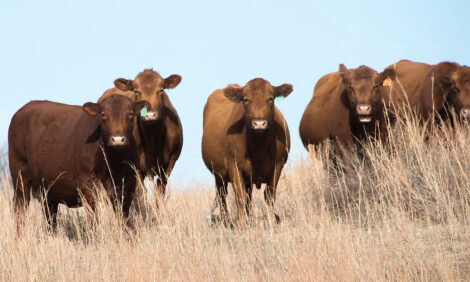



Beef Cattle Numbers Causing Concern
US - Declining beef inventories are causing some in the US cattle industry to wonder how beef production can be maintained.“The numbers tell the tale, which is that America’s cattle industry has effectively been turning fewer cattle into more pounds of beef,” said Derrell Peel, Oklahoma State University Cooperative Extension livestock marketing specialist.
The US beef cow herd has decreased 12 of the last 14 years, dropping from a cyclical peak of 35.3 million head in 1996 to the January 2010 level of 31.3 million head. This represents the smallest beef cow herd since 1963.
Combined with smaller dairy cow numbers, Mr Peel said the 2010 calf crop is expected to be 35.4 million head, the smallest US calf crop since 1950. Total US cattle inventory has decreased by almost 10 million head since 1996 to the January 2010 level of 93.7 million head, the smallest cattle inventory since 1959.
In contrast, total beef production has not changed accordingly. In fact, 2010 beef production is projected at 25.9 billion pounds, slightly higher than the 1996 level of 25.4 billion pounds.
“We have maintained production thus far in two primary ways,” Mr Peel said. “First, decreasing inventories allows the industry to utilise that inventory as production while numbers are declining.”
Second, between 1996 and 2006, cheap corn allowed the industry to feed animals to ever-increasing carcass weights and to feed lightweight calves for many days in feedlots. Feedlot inventories have thus been maintained by a slower rate of turnover.
“In effect, the US cattle industry has been able to effectively turn fewer cattle into more pounds of beef,” Mr Peel said. “However, the situation is now different.”
Expensive corn forces the industry to feed heavy yearlings and move them through the feedlot faster. Carcase weights in 2010 have been below year-ago levels almost all year and high feed costs likely limits carcase weights to little or no trend in coming years. A faster feedlot turnover rate exposes the shortage of cattle quickly as feedlots scramble to find sufficient supplies of feeder cattle to place on feed and maintain feedlot inventories.
“So far, we appear to have been able to do that,” Mr Peel said. “Total cattle slaughter for 2010 is running almost two per cent above 2009 levels. Steer slaughter is up less than one per cent this year. By contrast, heifer slaughter is up nearly three per cent and cow slaughter is up four per cent. It is clear that we are maintaining slaughter rates, in the short run, with our females.”
Mr Peel cautions this is not sustainable without accelerating herd liquidation. At some point, the US cattle industry will try to stabilize the herd size and then expand a bit.
“Given the current situation this implies a significant reduction in cattle slaughter in the short-term just to hold the cow herd size steady,” he said. “It seems likely this process will start in 2011.”



